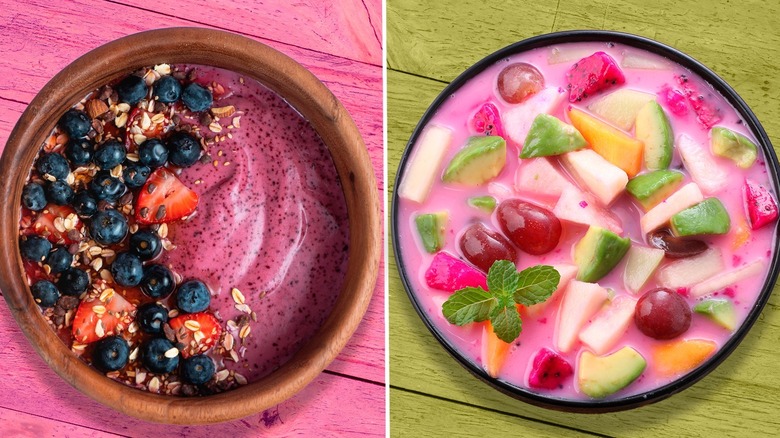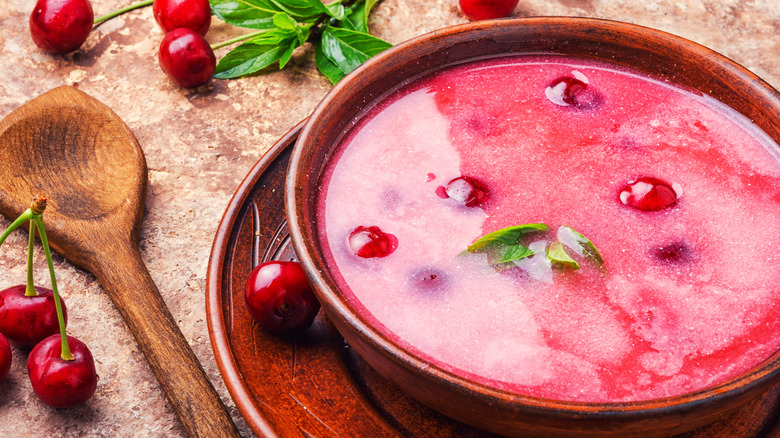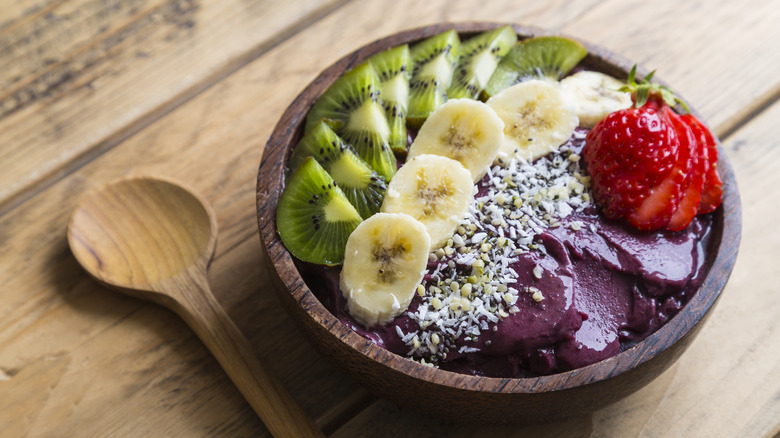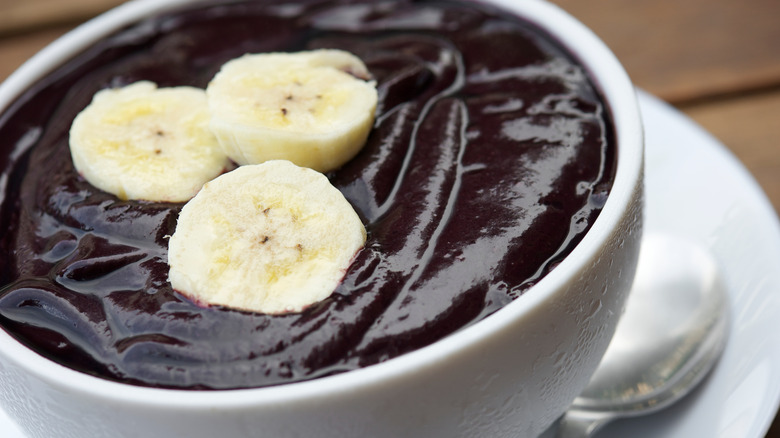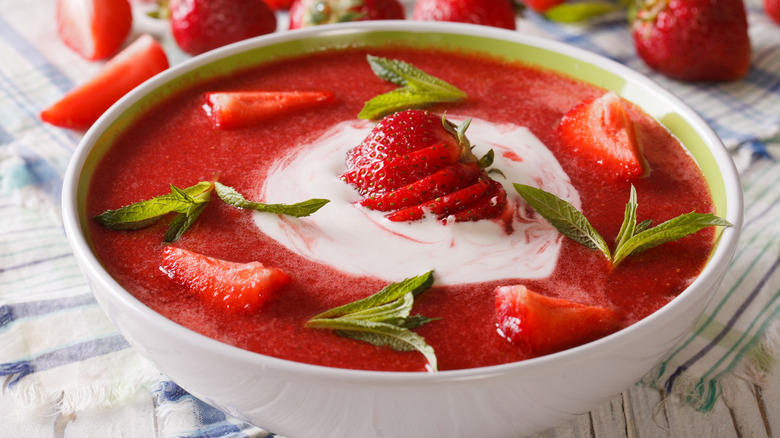What's The Difference Between Fruit Soup And Acai Bowls?
Fruits are delicious when they're raw, but they also make incredible culinary ingredients. Everyone should have a fruit pie recipe in their back pocket, after all, and fruit-flavored ice creams are always a hit. Besides these applications, fruits can also make great textural ingredients.
Take both the beloved breakfast favorite of the açaí bowl and all the variations of fruit soup. Both dishes rely on a flavorful medley of ingredients to achieve not only a specific taste but also a particular consistency. Served in a bowl, they both boast bright, vivid notes, making it easy to assume they're just different renditions of the same dish.
That's far from accurate, however; each of these foods is unique, and they have numerous differences. First of all, they have separate culinary origins: Açaí bowls took form among the restaurants of Rio de Janeiro, while fruit soup arose throughout various parts of Europe. The natures of these dishes are also different. An açaí bowl is dependably thick and based around a single ingredient, and it's invariably covered in toppings. Fruit soups have a thinner, more liquid consistency and can employ broader flavor palates. Regardless of which one you choose, you'll have a tasty experience, so don't neglect sampling fruit in either of these liquefied formats.
What is fruit soup?
At first, fruit soup may sound like an oxymoron. After all, naturally sweet foods are typically eaten after a meal, not as a liquid appetizer. In actuality, the name refers to a broad category of dishes, all of which are unified by being serving in a bowl. In Scandinavia, the dish is a traditional style of dessert called fruktsuppe. Its preparation requires a broad selection of whatever fruit is fresh and locally available — often stone fruit — combined with tart juices, gentle spices, and a dried-fruit foundation for flavor. The ingredients are slowly simmered alongside tapioca before they're served cold.
Similar fruit soup preparations occur in Hungary, where the dish is called gyümölcsleves. This rendition typically employs extra-tangy cherries, which are melded with a puree of sweeter fruits (like apples), as well as corn starch or sometimes sour cream. With such a tart palate, this dish can appear at either the start or conclusion of a meal.
Such an ambiguous balance of sweet and savory also encompasses soup recipes tweaked with fruit, like watermelon-flavored gazpachos or a silky carrot apple soup. Some people also debate whether or not smoothie bowls are a type of fruit soup, though most folks would likely place these in the beverage category.
What are açaí bowls?
Per its name, this food is all about the açaí fruit, which forms the dish's deliciously fragrant base. Since the fruit is difficult to transport to countries like the U.S., it's found exclusively in frozen form, hence why it gets pureed into an almost ice cream-like consistency. For the sake of both texture and flavor, many people blend in plant milks and additional fruits like bananas, strawberries, and even guarana, an Amazonian fruit with stimulating properties.
Atop this thick puree go a wide range of toppings, like homemade crunchy granola, various nut butters, more fresh fruit, coconut flakes, seeds, honey, and more. Picking out such a precise combinations of ingredients is one of the fun parts about visiting an açaí shop; the berry shines alongside a multitude of creative interpretations.
The dish's trendy appeal is understandable — it's light, energizing, and marketed as healthy. In this sweet format, however, it's a relatively young creation. It only appeared in large Brazilian cities during the 1980s and wasn't introduced to the U.S. until the late '90s. For centuries beforehand, açaí was already a dietary staple of ribeirinhos, indigenous residents of the Amazon jungle. They consume the açaí fruit — which tastes very earthy on its own — as either a juice or a complement to savory foods. As a result, serving the fruit as a sweet breakfast item is a relatively new (but incredibly popular) invention.
The two dishes have different textures
With only a brief glance at a fruit soup recipe, you might have a hard time distinguishing it from its savory counterpart. The European tradition of these fruit-filled creations often intersects with the American understanding of soup: ingredients boiled together in a pot and served at the start of a meal. Some people choose to integrate dumplings or even pasta into the mix, and many folks employ thickeners like corn starch or tapioca flour. So, while there are certainly variations in the final texture, the dish's consistency is usually that of a thin liquid.
This contrasts sharply with açaí bowls, which are expected to have a thicker texture. Inspect an at-home açaí bowl recipe, and you'll notice that the emphasis is on blending the fruit into a denser consistency (especially because the fruit is always sold frozen). You shouldn't be able to consume this dish with a straw, as it best shines with a thicker texture; at the same time, however, it must also be absent of large ice crystals and have a pleasant creaminess — a tricky balance to get right. With high-speed blending and a thought-out combination of ingredients, though, açaí bowls can delight with their textural richness, and this is a large part of their appeal.
Fruit soups encompass a wider range of recipes
Fruit soup recipes come from all around the world, so naturally, the dish has many variations. For instance, Scandinavian søtsuppe relies on a dried-fruit base for flavor, typically consisting of raisins, dried apples, and apricots, all of which are melded with seasonal additions like prunes or rhubarb and finished with spices. Its preparation is similar to that of Hungary's gyümölcsleves, though this latter iteration reaches for tart cherries as the base. Both dishes serve fruit bits in a liquid base, creating a varied textural experience.
In Poland, fruit soups are called zupa owocowa. These creations rely on the sweetness of strawberries (or other deseeded fruits) that are stewed with thickeners and contrasted with a tangy dairy or rhubarb finish. This rendition might contain some fruit bits, but overall, the dish is texturally consistent. Similarly uniform are the many gazpacho fruit soups, which can use everything from cherries to strawberries as a base.
The base flavor and texture of açaí bowls have less variation — after all, the dish is based on a single ingredient. The base can, however, run a little liquid-y, especially when it's not executed well. The best toppings for açaí bowls also vary, with each consumer favoring a specific mixture. Such nuances showcase the potential variation of the dish, but its fundamental composition is fairly steadfast — frozen fruit with toppings — and it's a delicious formula that certainly works.
